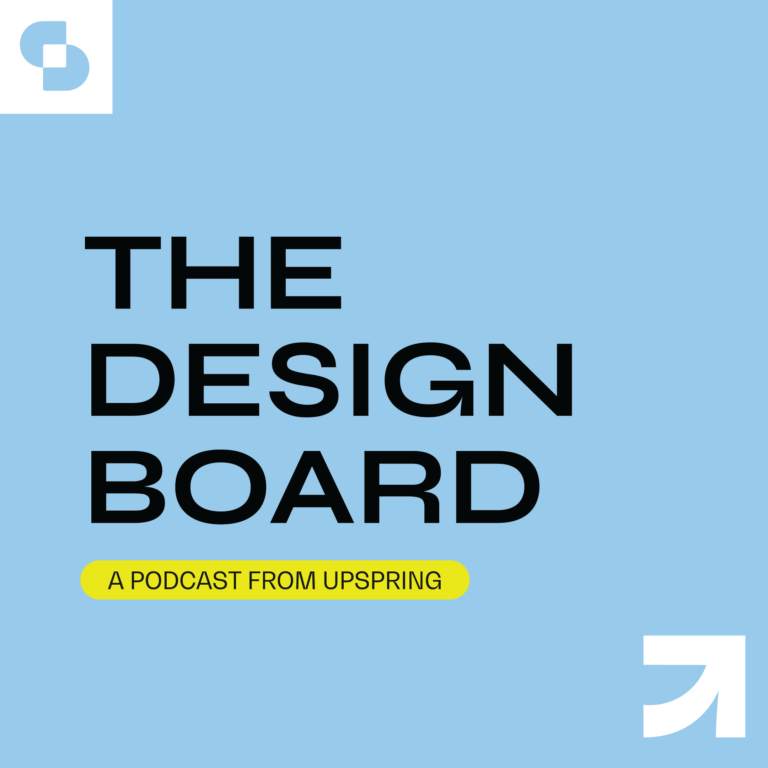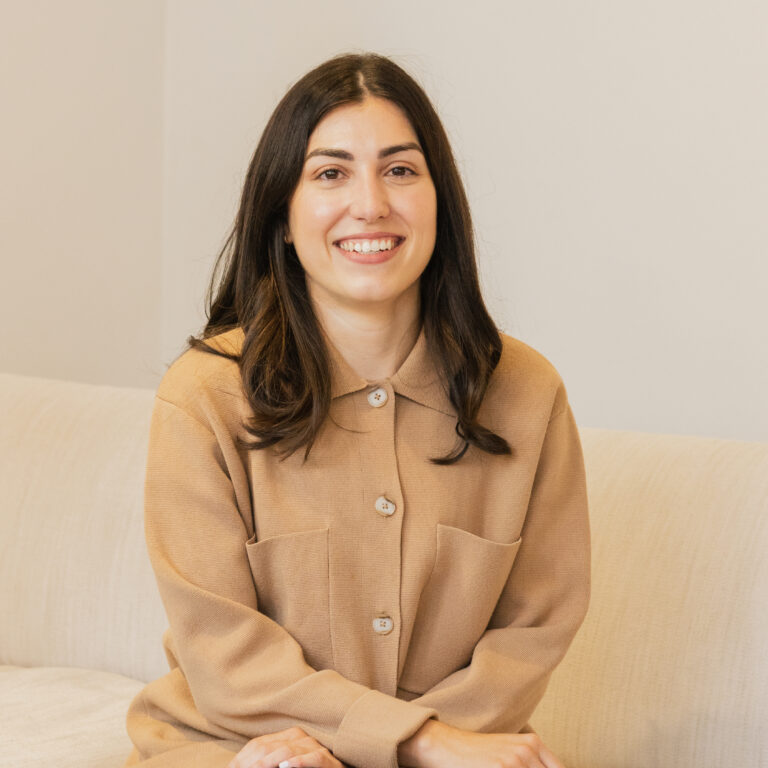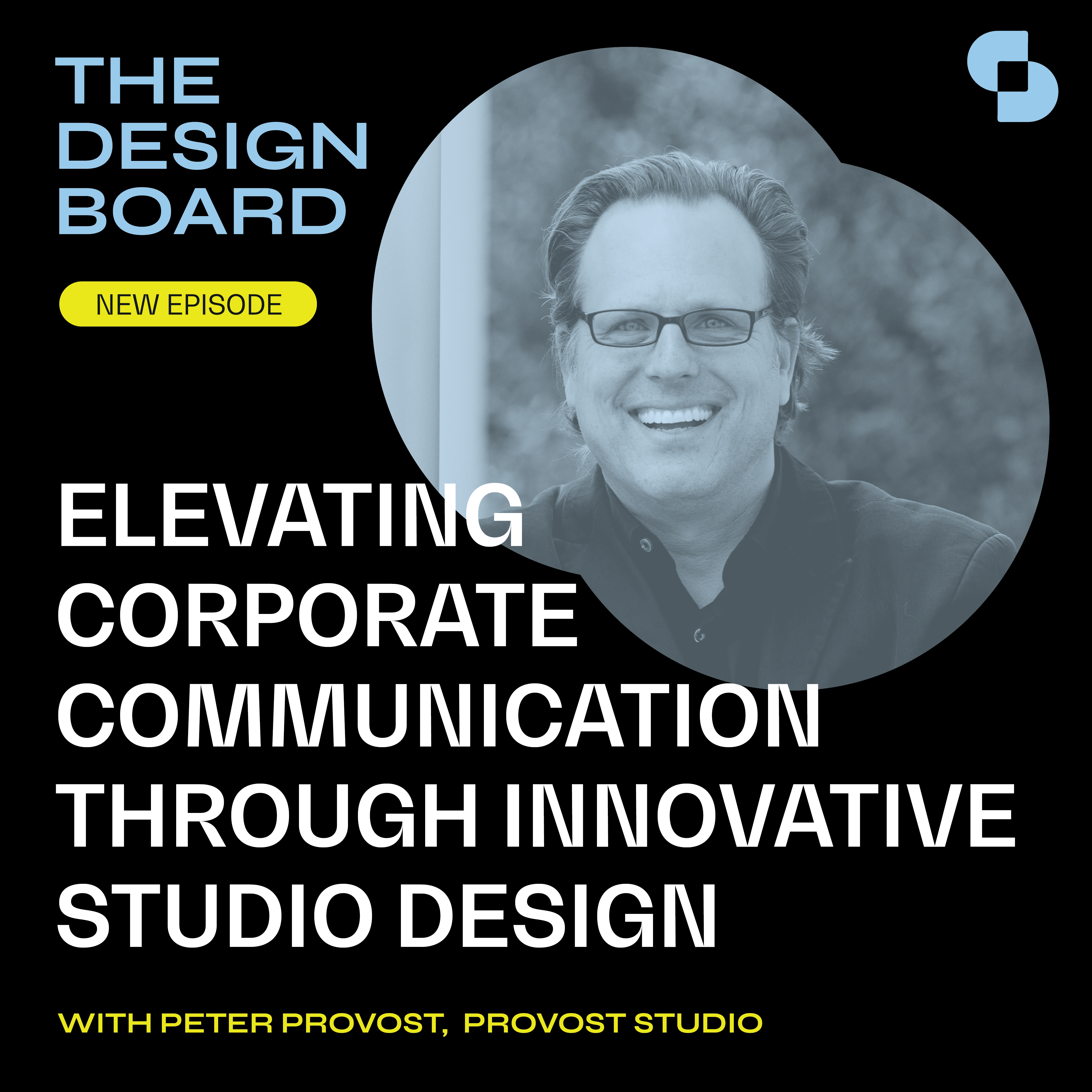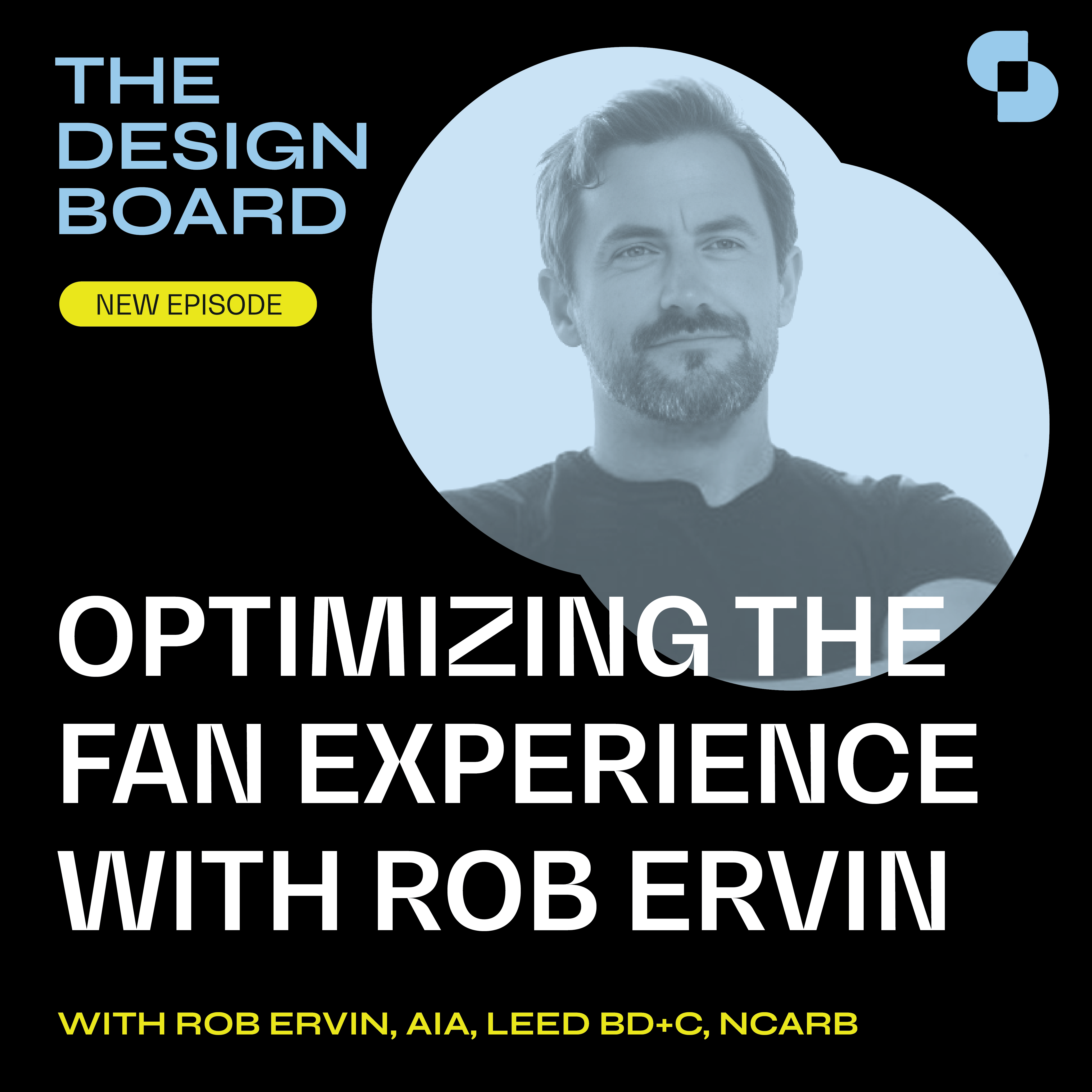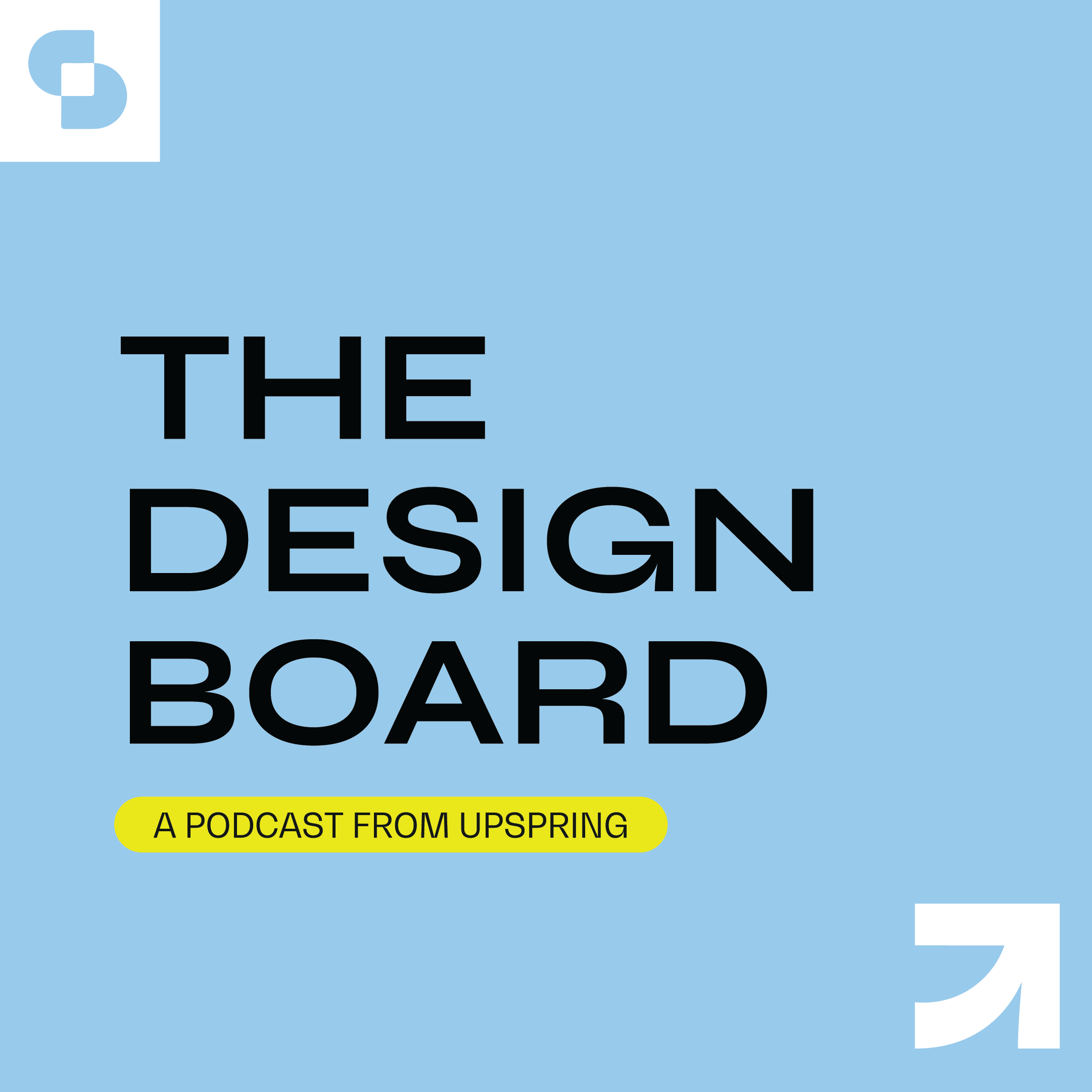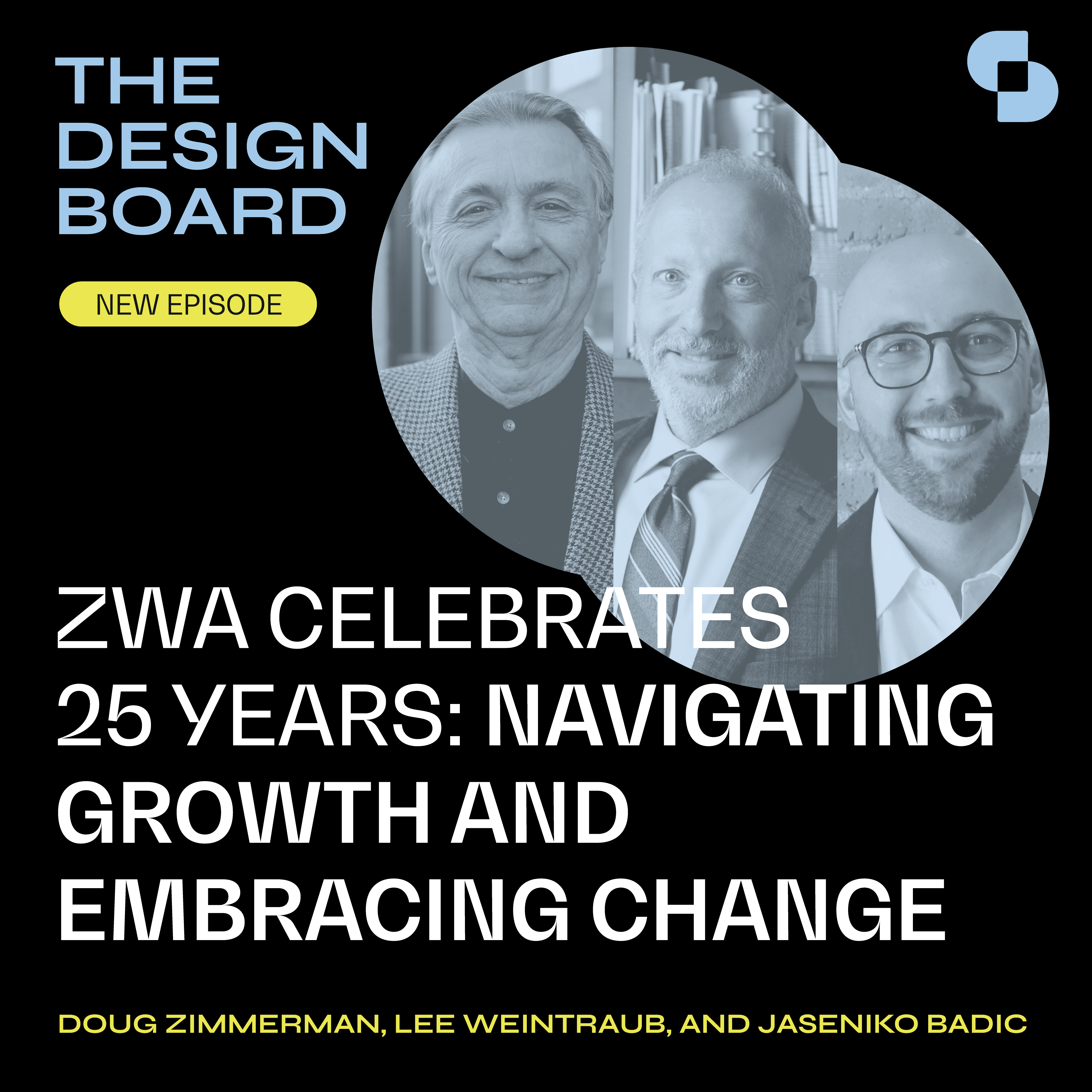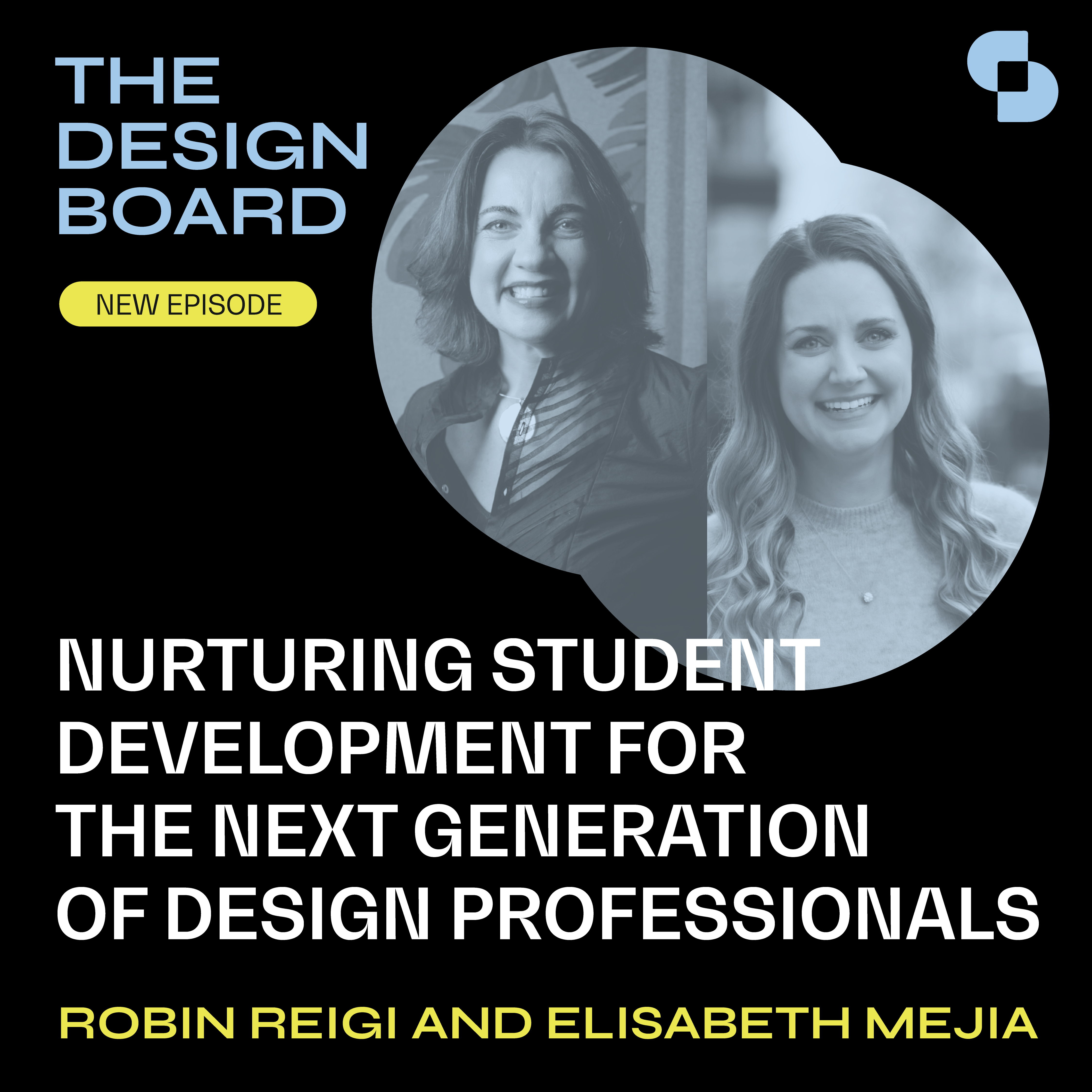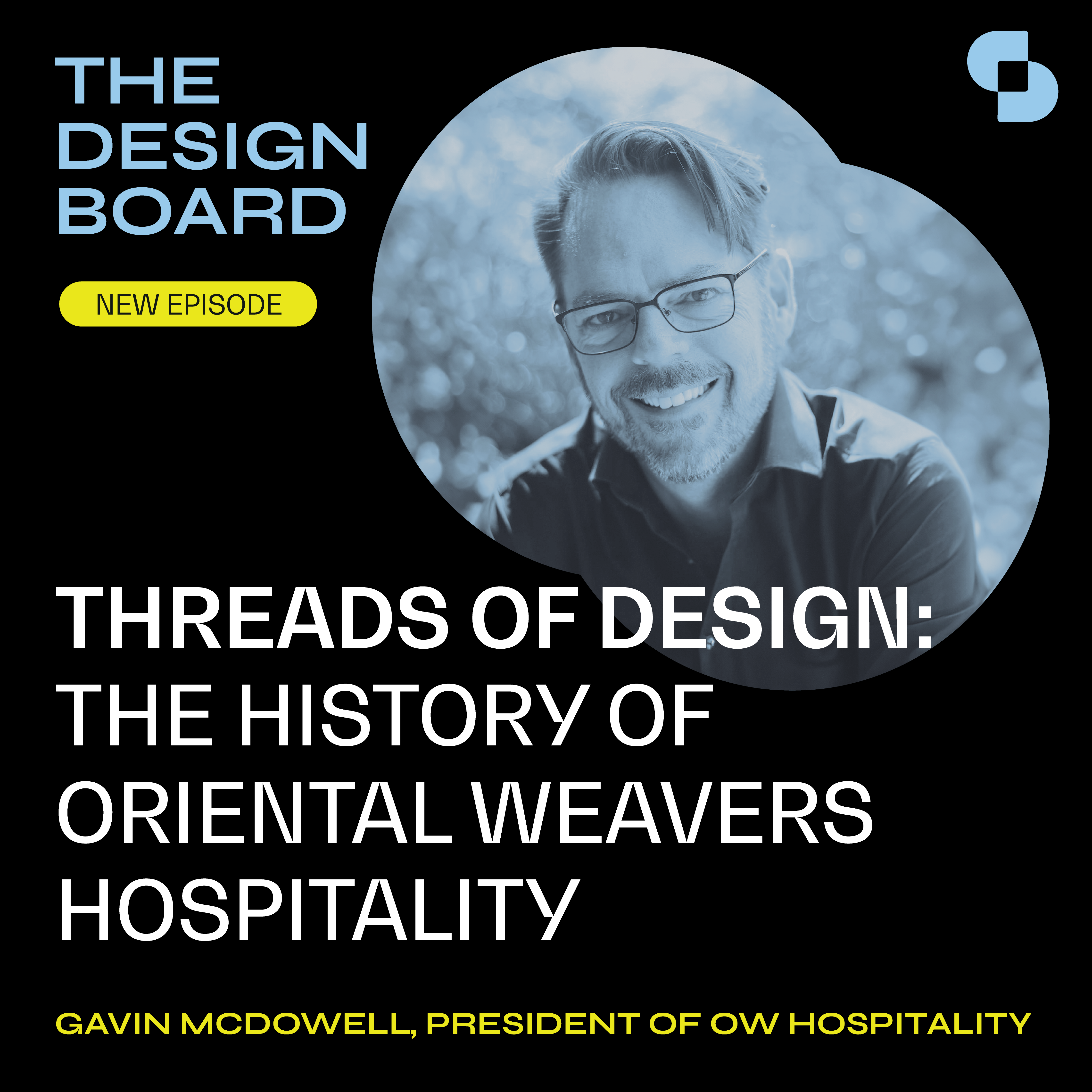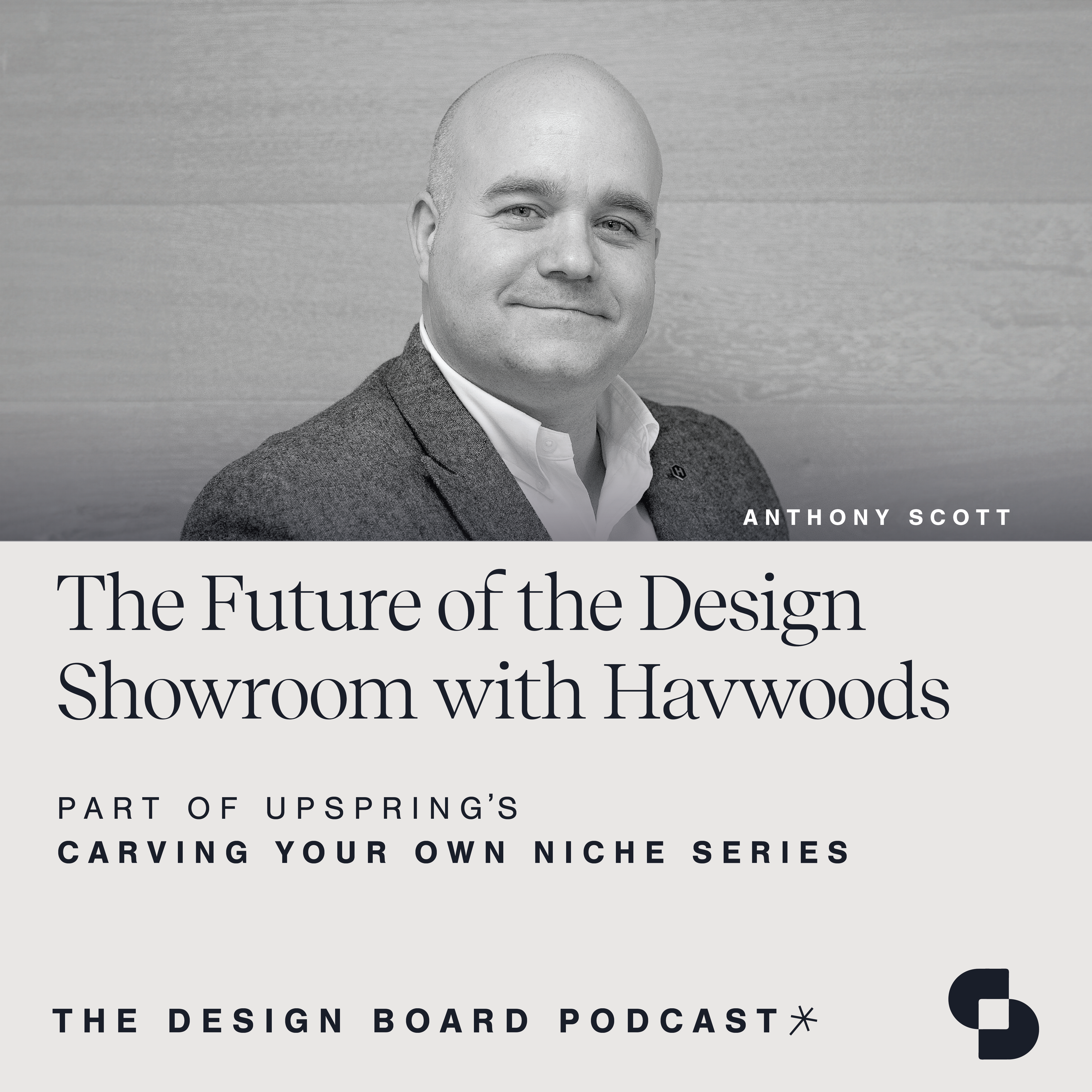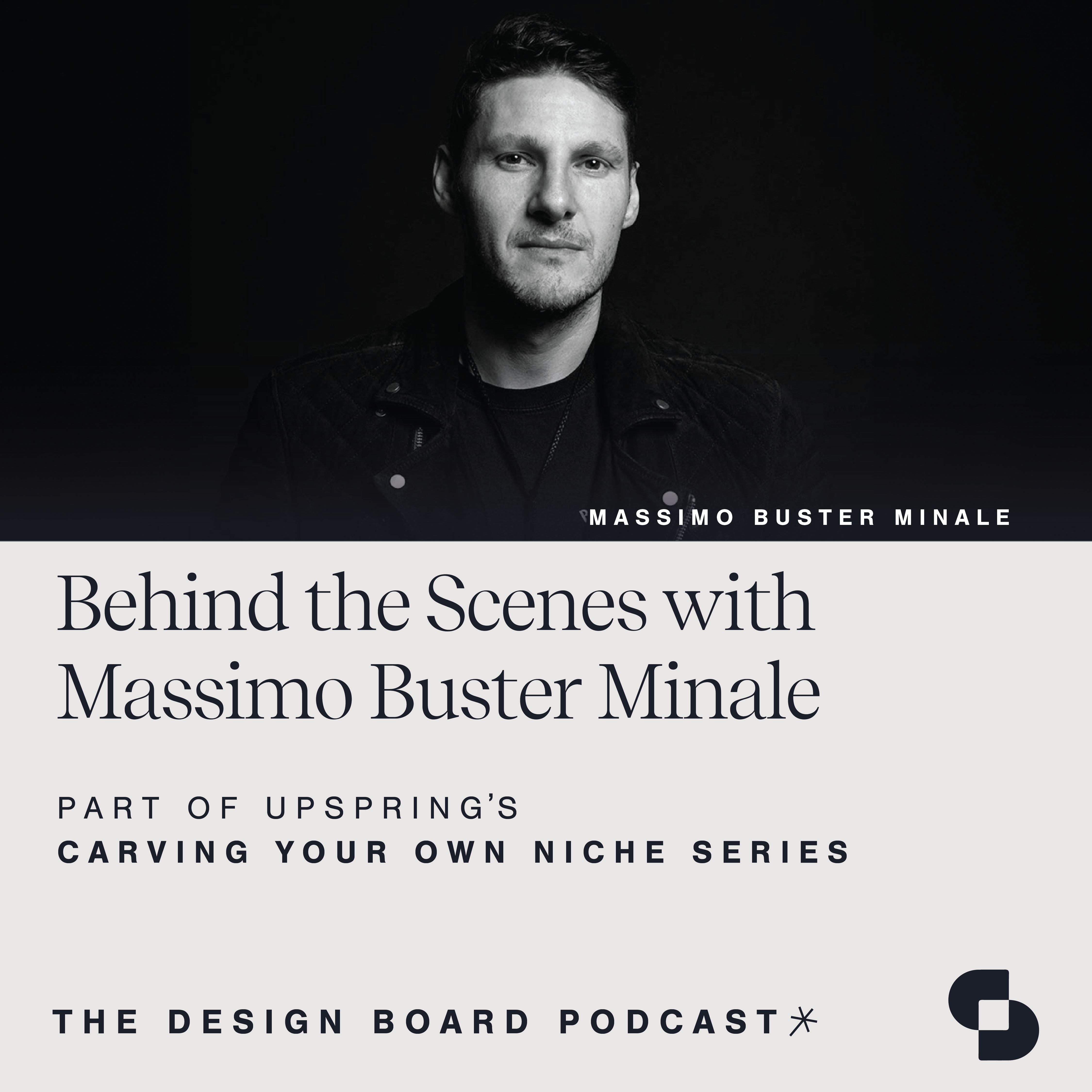It’s no secret architecture and design firms play a critical role in creating and shaping the built environment. So what does the future hold? With the rapid pace of technological innovation and the growing concern for sustainable practices, the future of architecture and design is shaping up to be very different from what we know today. In this episode, host Caroline Saba explores how our industry will evolve alongside Alec Zaballero, Managing Executive, TPG Architecture, and Haril A. Pandya, FAIA LEED AP, Principal and National Practice and Market Leader, NELSON Worldwide.
The Design Board, by UpSpring, is a proud member of SANDOW Design Group’s SURROUND Podcast Network, home to the architecture and design industry’s premier shows.
Caroline Saba:
Hi everyone, welcome to another episode of the Design Board. I’m your host, Caroline Saba, Vice President at Upspring. It’s no secret architecture and design firms play a critical role in creating and shaping the built environment. So what does the future hold? With the rapid pace of technological innovation and the growing concern for sustainable practices, The future of architecture and design is shaping up to be very different from what we know today. In this episode, we’ll explore how our industry has evolved and I’m here with Alec Zablero, managing executive at TPG Architecture, and Haril Pandya, principal and national practice and market leader at Nelson Worldwide. Thank you both for being here with me today.
Haril:
Thanks for having us.
Alec Zaballero:
Likewise.
Caroline Saba:
All right, so we’re going to start off with a pretty timely topic, the power of technology, which is spread across every news article over the past few weeks. How do you see technology shaping the future of architecture and design? Harrell, I’d like to start with you on this one.
Haril:
This one is so broad, right? I mean, I feel like by the end of this podcast, there’s gonna be something else technologically out there that we don’t even know about. So it’s moving at a pace that is just at a frenzy. I mean, I’m sure Alec and I can go back and forth and talk about when we first started using AutoCAD and first started using this sort of stuff. And it’s accelerated at breakneck speed to the point where the technology is controlling us. I’m sure we’ll talk about that too. But it is such a requirement, not only as a process to design, it’s so required in the things we are designing. So spaces have to be more technologically responsive, as much as we are using technology to create that space. So it’s a really interesting dialogue. And like I said, it’s only moving faster, and it’s getting smarter. So as we collect more data, and it’s interesting to say that architects or architecture firms are only in design. I think we’re a tech company as much as we are anything else, because we’re adapting and using tech in so many different ways. So I think just getting smarter about how we use technology, understanding and trying to get ahead of it, which, you know, it’s, that’s always a tough thing. But using different platforms, I think is really interesting. I don’t think architects, you know, thought much past CAD when technology was a big thing, but to actually now start looking at other social platforms, socializing design, socializing. input as far as creating design. So technology has sort of a input output component for designers. And I think it’s a lot to get your arms around. And I think if we’re not careful, the thing gets so far ahead of us that it becomes really difficult to control. And it is moving at that speed. I mean, this is not just old guy talking. This is really more like it is moving very quickly.
Caroline Saba:
Yeah, it’s moving so fast. Alec, what are your thoughts on this?
Alec Zaballero:
Yeah, so my thoughts, I agree with Haril. And so my thoughts are sort of, I will put two thoughts out there. The first of which is that technological change isn’t new. Technological change is constant. It is staring us in the face. It is happening incredibly quickly. And, you know, what that will mean is inevitably disruption. And the challenge facing us as architects and designers is going to be navigating that disruption to our practices, to our ways of working, to our businesses. But the flip side of disruption is opportunity. And I’m personally looking forward to working with my own personal AI.
Haril:
Oh
Caroline Saba:
No, that’s great. I like that you both have an optimistic outlook on it and are looking at technology as something that can improve what you’re doing on the day to day. So switching gears a bit, with the increasing demand for sustainable practices, how do you think architects and designers will incorporate green technology into their work moving forward? Alec, let’s start with you on this one.
Alec Zaballero:
Sure, so full disclosure, I did my masters in sustainability way, way, way back in the 20th century. So my perspective on sustainability actually spans a couple of generations of the sustainable debate, two, three, four generations of the sustainable debate at this point. And I think that what we’re seeing now is… that we are adopting sustainable practices into our work as most marketly as they become economically viable. As the economic argument for sustainable practices become stronger and stronger and stronger and more of these come on the market and more of these just become easier. to adopt and easier to incorporate into the work, then the more we are able to adopt the green technology into our work. Now, there’s a pull component to this. There’s the desire of our clients and ourselves as designers to incorporate green technology. There’s the push component to this. Energy code is only becoming more stringent. So the market is responding to push, and the market is responding to pull. I think that the degree to which you want to, you choose to incorporate sustainability into your work always has to be balanced. I can’t force a client to adopt sustainable practices. I can incorporate them into my own best practices and we try to.
Caroline Saba:
Yeah, I think that makes total sense. It has to come from both sides. Harrell, what about you?
Haril:
Yeah, I mean, Alec is spot on and it’s really interesting because, you know, sustainability, I’m going to air quotes sustainability for a second, because it’s a loaded word, but sustainability back in the quote, back here we go again, back in the day, here,
Haril:
sustainability in a way was a choice, you know, it was something that clients didn’t understand, therefore didn’t want. And I’m going to go back to technology a little bit because, you know, the the talking about it, the socializing of it, the understanding of it, and therefore the awareness of it becomes not only a popular mainstream thing now, rather it’s not a luxury like it used to be a few generations ago, it’s a necessity, and now it’s getting to the point where it’s a requirement.
Caroline Saba:
Mm-hmm.
Haril:
So it’s really kind of, it’s evolved thankfully, and it’s not just a fad, it’s a thing, it’s a here to stay. But it comes with all these different parameters, right? So like Alec was saying, there’s sustainable practice. There’s us being good designers, good architects picking the right materials, and that sort of thing. It’s like low VOC paints, all that kind of stuff that we pick sensibly sourced wood, etc. from a materiality. Then on the practice side of things, I think it’s interesting because there’s an energy component which Alec touched upon. Back in the day, we’re like, oh, we just swapped out our incandescent bulb with an LED bulb. And hey, we just practice sustainability. Sure, to a degree, there’s a piece of that for sure. But a little bit of what I do in the practice is I do a lot of repositioning, adaptive reuse. And to me, there’s a practice of sustainability. I’m not knocking it down. I’m adding, I’m extending its longevity. Right? And that’s what we’re doing. We’re smartly introducing materials that will outlast. And they’re smart from where they’ve come from. And sort of the practice now, you know, and a lot of areas is with economics, sorry, the economy moving the way it’s moving, it’s too expensive to knock things down and rebuild, right?
Caroline Saba:
Mm-hmm.
Haril:
Especially post COVID, when we’re sourcing these things and we’re having such a hard time getting materials and it’s increasing the cost, we have to be smarter. So we have to think of sustainable ways. You can’t necessarily knock down buildings. Can you reuse them? Can you, you know, capitalize, if for nothing else, on a way of like making these… Structures last longer. I think that’s a sustainable way of thinking. It’s a sustainable practice But again, there is that sort of dichotomy of materials practice Methodology and I can agree with Alec more like our clients are getting more and more savvy about it, right? So they it’s becoming something that they’re going after and and cities and towns I think Cambridge Massachusetts is like requiring projects even renovations to be gold, you know, so it’s it’s it’s moving We’re in towns and other cities are saying it’s got to be electric buildings only. There’s no more no more fossil fuels you know, for that sort of thing. So it’s just, it’s moving, you know?
Caroline Saba:
Yeah, you touch on a lot of interesting points there. And I think both of you are saying it’s no longer a choice. And I think we’re seeing that in the everyday person, too. They want to see brands, companies, organizations pushing that sustainable dial forward. So it’s interesting to see both of your perspectives there. As populations grow, Harrell, how do you see architects and designers adapting to create more efficient and livable spaces?
Haril:
Well, I think efficiency again a little bit eye of the beholder because I think, you know, it’s all about if you ask a developer what’s efficient, I would imagine they would say it’s like what I can charge rent for what I can sell. Right? So there’s an efficiency
Caroline Saba:
Mm-hmm.
Haril:
to that. So things can be either rectangular. So they’re efficient. There’s that there’s that side of it as we design less waste of space, less, you know, unusable spaces. There’s that kind of efficiency. But when you’re talking about livable spaces, you know, we’re actually, we’re getting more efficient in one way in the sense that because of, again, just a little bit of the post-COVID, you know, our homes have to have office components now to them so they become an efficient living space because I can do more things in one area. You know, and there’s a little bit of that reverse happening where a lot of office buildings and stuff that we look at these days, they need to have these hospitality or residential level components because it’s efficient to keep people there longer. So there’s this notion of like, how do we get the most out of the spaces that we have? It doesn’t necessarily mean designing smaller. There was a time when you look at workspaces and stuff before COVID or like a company like WeWorking, are you down like 70, 80 square feet per person? That is tight. You are elbow to elbow. Because it was just we can get more folks. That’s that sort of thing. But then if you go across the ocean there, you’re looking at two countries that almost… taking almost half the population of the world, not far from it, it’s places like that that have to really, really think about efficiency, really, really think about the quality of life, the quality of these living spaces, natural air, natural light, all these things. And sometimes creating that level of comfort not only costs more, it can be more difficult, again, especially in the existing buildings. So I think it’s adapting to not only where climatologically and geographically that we’re designing for, but also the who. If Alec and I were working on a project together and it happened to be in Shanghai, we would look at it in a very different way than we would look at it in New York City, even though they’re both very dense populations.
Alec Zaballero:
Yeah.
Haril:
I think there would be a level of efficiency into those living spaces. However, the commonality is always we want to make great livable spaces, great experience, natural air, light, natural light, et cetera. there’s some fundamental rules that are, I don’t think will really ever go away. And then again, post COVID, we’re seeing more and more people want outdoor spaces, right? So again, you sort of made things a little less efficient because you’re trying to create more spaces rather than doing more in the similar space. So it’s, I’m not really answering your question frankly, but because I don’t think we’re adapting as much, I think we’re being challenged, you know, more and
Caroline Saba:
Yeah.
Haril:
more about how to create these spaces. So efficiency, again, like I said in the beginning, a little bit eye to be holder.
Alec Zaballero:
Well,
Caroline Saba:
Yeah.
Alec Zaballero:
what I love about this, okay, so what I love about the question is the sort of looking at the question under the question, because
Caroline Saba:
I’m going to
Alec Zaballero:
we
Caroline Saba:
go to bed.
Alec Zaballero:
say, you know, as urban populations grow and we’re talking about efficient livable. So there, what we’re really in some ways saying is that, you know, urbanism is a more and more important and dominant model. And we’ve seen this over the course of the pandemic, over the course of recent years. the urbanist ideal is sort of becoming more and more dominant. And along with that, the reclaiming of public space, the reclaiming of green space, where are we living now and how are we living? And so the livability question comes in. When we say efficient and livable, well, efficient doesn’t necessarily mean smaller. I completely agree. Efficient could mean that we’re doing more things better in more spaces. And I’m a real Personally, I’m a proponent of an urbanist way of life. I live in Brooklyn, I work in Manhattan, couldn’t get more urban than that.
Caroline Saba:
Hehehe
Alec Zaballero:
But in many ways that is the most sustainable from an impact point of view, from a richness point of view. So I think that the demand that we see is for spaces for architecture and design that is more engaged, that is more livable, that is more multi-purpose, that is more connected to the street and the green space and to our personal lives and our work lives.
Caroline Saba:
I love this. I feel like we could spend the next 45 minutes talking about this question alone.
Haril:
Easily. Quite easily.
Alec Zaballero:
Easily. Easily.
Haril:
Any of these, frankly. Ha ha ha.
Caroline Saba:
Well, we might need to do a follow up. I mean, you’ve seen so many conversations and arguments for and against to like the 15 minutes city and having everything at your fingertips and what that looks like with the community engagement. So there’s definitely a lot to unpack there. I agree.
Alec Zaballero:
The
Caroline Saba:
I
Alec Zaballero:
15-minute
Caroline Saba:
think it’s interesting.
Alec Zaballero:
city isn’t a new idea. We had 15-minute cities.
Caroline Saba:
Yeah.
Alec Zaballero:
and then lost them for
Haril:
Marketing,
Alec Zaballero:
the most
Haril:
it’s
Alec Zaballero:
part.
Haril:
all marketing.
Caroline Saba:
Marketing.
Alec Zaballero:
Yeah. Yeah.
Caroline Saba:
The power of good marketing, it’s very true. Well, we started to touch on this too, Haril, you mentioned, you know, people in their living space, if they’re working from home and or going into the office, they need to have space to, you know, plug in and have heads down work. So I’d love to hear too, from an architect’s perspective, with the rise of remote work and virtual collaboration. How is this impacting the way that architects and designers are working together on projects?
Haril:
You know, this has been like, this has been the knife in the architectural heart because we are, we survive by collaborating together. It is a collaborative profession, which, you know, ironically, even though Alec and I went to the same school, we
Caroline Saba:
Thanks for
Haril:
have
Caroline Saba:
watching!
Haril:
this very independent approach because you have to grow yourself as a designer, ultimately to be thrown into the den of multiple architects and designers to work collaboratively together. And you get used to it. So after school of doing it three, four, five years, You end up saying, well, I’ve got the chops to do X, Y, and Z, but then you have to go to a firm, and you’re working with 20, 30, 40, 100 people. It becomes really interesting. So when you take it away, and you don’t understand the power of it until it’s gone, and I think COVID took it away,
Caroline Saba:
Mm-hmm.
Haril:
and I think that is a huge life lesson in professions like ours that thrive on discourse, on discussion, having talks like this with each other. showing each other and sharing work. What do you think of this? Being more collaborative, and it’s like the C word we always use, but at the same time, we feed off each other’s energy. Cause guess what? At the end of the day, we’re people and we need that, right? People need people and
Caroline Saba:
Yeah.
Haril:
a story. And I think no matter how much AI shows up, people will need people. But I think now that everything is like remote and it’s virtual, it’s become a… a harder use of our time. I have Zoom calls that are back to back. I would never have meetings back in the day that are back to back. So that’s a real challenge, right? It’s taking a lot of mental energy and capacity to get through a day. Because normally in a day, I don’t know, I like three, four meetings maybe, like a type of thing, instead of having eight in a day, it’s kind of crazy. So remote is doing that. It’s forcing us not to work collaboratively. Like here we are. I’d rather be in a room with you guys in a way doing
Caroline Saba:
Yeah.
Haril:
this.
Alec Zaballero:
Absolutely.
Haril:
There’s a little bit of that charm that gets taken away, the connectivity, body language, all that kind of stuff that you really need. And when it’s, again, when it’s removed or it’s forced upon to do it virtually, it’s tough. This is not how we’re wired. This is not our DNA to be separate.
Caroline Saba:
So
Haril:
You know,
Caroline Saba:
true.
Haril:
we’re communal people, communal beings, I should say. So I would say that it’s not going away. I know that’s one thing is people have learned to figure it out. But as it specifically relates to architects and designers, I think, you know, to produce the best work, we have to do it together.
Caroline Saba:
Yeah, I would
Haril:
Sorry,
Caroline Saba:
agree.
Haril:
in-person
Caroline Saba:
I
Haril:
rather, I should say together.
Caroline Saba:
think creativity comes from that collaboration, like you’re saying.
Alec Zaballero:
I agree and I’ll add just one more thing. So I’m sitting in our offices here, you know, and I make it a habit to be here at least four to five, four if not five days a week. And a big reason for me to be here is, what is it? 90% of, you know, life is showing up, right? Is that the people, so the members of our team who are the most ardent, proponents who are in the office the most are actually our most junior members. People,
Caroline Saba:
Interesting.
Alec Zaballero:
you know, because for, if you think about our profession, our profession, you, you, you learn by, but you, you learn through your pores, you learn from watching others, you learn in, in, in the work setting in studio. And, and this is for them, the most critical part of their career. It’s the first few years at a school. So, so, so for me, I make it a point to like be there. And, and you know, that, that we have to think in terms of not only investing in, in, in how we work on a database basis, but how we’re growing our, our practices.
Haril:
And it doesn’t matter how much AI gets thrown at us. And at the end of the day, I don’t care how many robots are working with us
Caroline Saba:
Hehehehe
Haril:
down the road. You know, the, the mentorship and growth of an individual as a designer, we have always been an apprentice based profession. And that’s not going to change. I don’t think, I mean, at least from that growth perspective, Alec is dead on. Like you go in there and you want to be able to, you know, mentor these, mentor these students that are coming out. And I can’t unroll a piece of trace and a pen and start drawing and do things on the screen. I can use zoom to draw, but it’s not, it’s just.
Caroline Saba:
Not the
Haril:
It’s
Caroline Saba:
same.
Haril:
so challenging. We’re adapting. There you go. We’re adapting from that perspective to draw on screen rather than draw in person. But, you know, that, that mentorship is so key in this for even our, even at this age or level, our years of experience. I’d rather sit in a room with Alec and talk and draw and do that sort of thing as well. Right. We just get more out of it.
Caroline Saba:
Yeah, I totally agree. I think that mentorship inspires innovation too and that does need to happen in person like you’re saying. They see their understanding, their learning from those around them.
Haril:
I don’t have to set a Zoom call to get up and go to a desk and ask somebody,
Caroline Saba:
Totally.
Haril:
how’s the project coming along? How’s the deadline come along? And by the way, how are you doing?
Caroline Saba:
Yeah.
Haril:
Right, that’s another thing, how are you doing? And I
Caroline Saba:
Yeah.
Haril:
think that’s, we’re challenged with that.
Alec Zaballero:
What we have to recapture, and communication doesn’t happen in this little box, right? This is very overt, very deliberate, very packaged communication. It’s not all, we’re missing all the nonverbal cues. We’re missing all of
Caroline Saba:
Mm-hmm.
Alec Zaballero:
the non-obvious communication that takes place. And we forget that sometimes. I wish
Caroline Saba:
Yeah,
Alec Zaballero:
I was
Caroline Saba:
absolutely.
Alec Zaballero:
in the room with Haril. reminisce
Caroline Saba:
Oh,
Alec Zaballero:
about
Caroline Saba:
next time.
Alec Zaballero:
the green building.
Haril:
talk about the goal and I break out the guitar. We make a musical. I don’t know.
Caroline Saba:
Yeah, seriously, all those guitars back there. No, that’s great. I agree. I think, like you were saying earlier, how you started responding, the power of connection is so important. So just to segue into another hot button topic, the issues of social equity and inclusion. And I’d love to hear from both of your perspective how architecture and design can address these issues. Maybe Alec, we could start with you on this one.
Alec Zaballero:
Sure. I mean social equity, I’ll say one thing is that it has to start from within. It has to start with your own culture. As the leaders of our practices, we’re responsible for creating our own cultures. And we’re responsible for establishing that culture and nurturing that culture. So the values of social equity, the values of inclusion, the values of… fairness to the extent that we can address these issues as the leaders of our own businesses and practices. It has to start, I think, at home. It’s a home being where I’m sitting in the office. And then you can legitimately start to carry that outward, carry that into your work, understand it from the inside, because then you’ve got that lens, that perspective. It’s, you know, unless a client is overt about this being their mission, I don’t think that we’re in a position to sort of to dictate it, to impose it. I think it’s more, quote unquote, subversive than that. I think it’s something that we just carry through into design. These are proposing ideas that make for. sort of more open spaces, more open workplaces, more democratic interactions in built space.
Caroline Saba:
Yeah, I like that. Hurrah, what about you on this one?
Haril:
You know, it’s again, if I just get in my DeLorean and go back a few years, it’s really, it used to be like things like the Fair Housing Act or used to be like the advent and acceptance of ADA. So those types of things created access, right? So people can get from point A to point B. The inclusionary side and the equity side means, okay, we’re there. Are we all able to do and see and participate in the same thing? That’s the equity side of it.
Caroline Saba:
Mm-hmm.
Haril:
And I think that That is as important as it is. It’s subtle because I don’t think everyone necessarily when we’re designing clients, et cetera, understand or the difference between creating places to get to versus making sure that once they’re there, they’re all able to participate in a very equal way. I think it’s just being brought to light. These Jedi initiatives, justice, equality, diversity, inclusion are like really… They’re really taking the front stage, like sustainability is taking the front stage. I think it’s people want to make sure that the experience is a level playing field. And I think that’s, there’s nothing wrong with, there was never anything wrong in that area. I don’t think our architects 50 years ago are like, no, you can’t go there. We’re gonna make sure you can’t get there. That’s just not how we’re programmed. It’s all spaces and places for everyone. So that I think has now morphed into a little bit more of a. a nomenclature or a movement, which is great to make sure that these things are at the top of the list.
Caroline Saba:
Yeah, I think you both touched on it, how it’s more top of mind now than ever before, which I think is important. And then with the pandemic changing the way we live and work, we started to touch on this a little bit when we were chatting about the 15 minute cities idea, but What impact do you think this will have on the design of buildings and spaces in the future? Really, what impact will we see in our communities in the day to day? Alec, I see you laughing a bit, so maybe we’ll start with you. Ha ha
Haril:
Ha.
Caroline Saba:
ha ha.
Alec Zaballero:
I’m laughing a bit because… So I’m laughing a bit because we’re talking about, here we are, the question is about the pandemic. And yet in many ways, we’re already past the pandemic in terms of behavior, right?
Caroline Saba:
True.
Alec Zaballero:
I mean, Caroline, bars, restaurants, the streets, the tourists
Caroline Saba:
True.
Alec Zaballero:
are back, the hotels are at capacity, right? But what has the pandemic then left us? The pandemic, you know, in many ways accelerated certain things that were, so we have to look behind the pandemic and say, well, Why did we move to social? Was remote working and was Zoom and was this thing, you know, only, did it only happen because of the pandemic? No, it was already happening and there are other forces at play. You know, labor shortages are real, they’re demographic, they’re the big picture here. So these things were already in play, remote work, remote offices. I really, you guys have multiple offices, right? You’ve got to be able to communicate across offices. We have, the world is flat. I mean, that was already something that was in play. And in many ways, the pandemic accelerated it. Didn’t create the movement, really. Simply sort of accelerated the way that the movement towards this. So we’ve accelerated these factors. They will certainly affect how we design spaces moving forward. But I don’t think, you know, I think in many ways we’re past the pandemic. I mean, it was a disruptor. It kicked us all in the butt
Caroline Saba:
Mm-hmm.
Alec Zaballero:
many times. It taught us lots of very valuable lessons about what we could do with this form of communicating.
Caroline Saba:
Yeah, that’s so true. Harro, what about you?
Haril:
Yeah, I mean, you know, look, this is maybe an odd analogy, but sometimes, you know, as people, we need something impactful to make changes, right? I mean, sometimes, sadly, you know, you have to experience, in worse extreme cases, a heart attack to know that you know you need to be exercising. Why didn’t I do it before?
Caroline Saba:
Mm-hmm.
Haril:
Alex is right. Why didn’t we do these things before? So these mass behavior changes as a result of a global pandemic, for example. you know, is they leave fingerprints behind. I often say like, you know, the ghosts of 9-11, when 9-11 happened, mass, you know, big changes in design. Look at the way security is done, whether you’re
Caroline Saba:
True.
Haril:
in a building, that stuff’s not going away. Those fingerprints are left behind as a result of a mass behavioral change. And the pandemic is no different. So the ghosts of COVID and what are they gonna be and what are we gonna be left behind with that are not gonna change. So I think, you know, I would say the average person probably washes their hands far more often than they used to. Thank God.
Caroline Saba:
until they’re dry.
Haril:
But other than that sort of level of basic, from a design side, access to outdoor, access to sort of biophilic design, access to making sure that people are not in tight, efficient tiny spaces anymore because it’s like there’s a little bit of a factor to it. So I think, yeah, it is behind us, thankfully. in many ways and for the most part, people wanna just get back to it, get back to the bars and restaurants and hotels and travel. And with the labor shortages, that’s just making the challenge. So Alec is spot on. But the ghosts of COVID, I think are yet to be really seen because I think it’ll take a while for things to do that from a design perspective. Like I said, I think there are things like, creating certain distances, making sure there’s choice of space. So for example, If you’re a small office and you’re an office of, let’s say, 30, right, and you’re occupying a space in a building somewhere, you’re not going to have a big conference room. You’re not going to have a place to work other than your office, at least in the old days. But now, the notion of third space and other areas to get work done and be further apart give you choice, give you different experience. Maybe it’s outside, maybe it’s inside. So there’s digital connectivity as a result of all that. Now you can work from home. You have the choice. So the flexibility, that’s one of the ghosts, I think, of COVID that is not gonna go.
Alec Zaballero:
it were remarkably contradictory creatures, human beings, because yeah, there’s so much of this is perception. We’re so willing to like to sit cheek by jowl in that cool restaurant in the village, right? It’s like, okay, I literally have like one foot, if even one foot between me and the next person, right? Because we really wanna be there. And yet we’re like, okay, we need more, we need to. give people like space in other settings. We’re remarkably contradictory. I agree, it’s social fingerprints. We’re prepped for the next crazy thing to come. We’re prepped for the next, we’re living through a lot of stuff. We’re living through ecological stuff, through climate stuff. These are a lot of the things that were predicted. And
Caroline Saba:
Yeah.
Alec Zaballero:
We’re prepped for the next thing.
Haril:
Yeah, and
Caroline Saba:
Yeah.
Haril:
it’s funny, as you’ll see, we’ll have clients and literally CEOs of these big, big, big companies, and they’re always like, well, Harrell, what’s the future of remote work? I almost go back, I’m like, what do you want it to be? Like, do you want me to, are you asking me to be predictive? I can tell you what I’ve done in the past two years, but that’s no indicator per se of what’s happening in the future. What’s the culture of your company? What do you want it to be? And we’ll do it. Do you have the opportunity to be remote? Yeah, now you do. You didn’t before as much. So now you do. So what do you want that culture to be? You tell us now. in a way, rather than us being forecasting.
Alec Zaballero:
past performance is no guarantee of future results.
Haril:
Exactly. Very true. It’s very
Caroline Saba:
I
Haril:
true.
Caroline Saba:
love this.
Haril:
And you know, and we were, you know, it was an extreme situation, right? You know, we have to, have to, have to. And we also have hybrid rules still, you know, in place at Nelson. So, you know, I think we’re making sure that there is a level of flexibility. I’m sure it’ll all ultimately reset itself with the ghosts of COVID left behind. It’s just a matter of understanding what it is.
Caroline Saba:
I love the ghost of COVID. Hopefully that doesn’t haunt me tonight. Now I think this is really interesting. I love both of your perspectives on this. And we’re starting to talk a lot about what the improvements on the built environment have been since the pandemic. And I’d like to hear from both of you too on if there has been an increase in data collection and analysis that has led you to some of these conclusions or are informing some of the design decisions that you’re making. Well, we can start with you on this one. Hehehehe The
Haril:
Oh,
Caroline Saba:
hot
Haril:
okay.
Caroline Saba:
seat.
Haril:
You know, I guess you define, you know, data collection. So for example, we did a project a few years ago with like, you know, MIT’s Media Lab, and we’re saying like, well, how do you, in an office space or in a, you know, in a conference room or whatever, some large, a large place where people can use multiple places, can you actually understand and collect data of which rooms are the most popular, which areas are the most popular? Can you collect fob key data and say, well, 38 people went into that room, or there’s only four went into that room. There’s a way of understanding usage as far as how you want it to design. When you think of data collection analysis, are you thinking Alexa and Facebook, or are we thinking that level of data analysis? I don’t think architects are doing that. If they are, I would love to talk to them because that’s pretty interesting. If they are, I don’t think it’s there yet. upfront design workshops and brainstorm sessions with a subset of who we’re designing for is the data collection. So we’ll say we’ll want a substrata of the senior leadership decision makers to the everyday person that’s going to be there and sort of understand what do you want? What do you want? You kind of data collect, right? So you can kind of, you’re not designing by popularity, but in a way you’re kind of designing by popularity because you don’t want these spaces to be unsuccessful in the eyes of the client that you’re designing for. So We will collect data from that perspective. We’ll collect data for what fees we’ve charged over the past 10 years. We’ll collect data of what construction costs have been just from our own purposes. So yeah, the notion of data collecting is absolutely prevalent in the design profession for sure. I don’t know if it necessarily interprets to how we design space because that’s an evolution of generations. That’s a geological thing. That’s a climatological thing. There’s all kinds of things that change and adapt from that perspective. So… Yeah, and I’m a nerd about talking about generational design. I think it’s just so interesting of what people wanted 50 years ago and how we want stuff now, especially if you have young kids, it’s like, ah, it’s mind blowing
Caroline Saba:
Hehehe
Haril:
what they want versus what we want.
Alec Zaballero:
Mm-hmm.
Caroline Saba:
Yeah, I’m sure. Alec, what about you?
Alec Zaballero:
Well, you know, we’ve never been, it’s very difficult to collect data within, within spaces. I agree with Haril. You could do controlled studies and that kind of thing, but that’s not in some ways real world. What is very real world, what is the most, you know, the, is, is the data, is the, this data.
Caroline Saba:
Mm-hmm.
Alec Zaballero:
You know, the biggest trick was that some, you know, somehow we convinced people to carry you know, geo located supercomputers around in their pockets everywhere. And to, to put more and more and more of their lives on to, on these, on these supercomputers in, in forms of data that can be read by the algorithm and, and where I see, you know, data collection, you know, sort of affecting, affecting us most is, is in the way that it’s affecting the decisions of our clients. It’s in the way that it’s affecting the decisions of our clients regarding where they put projects, real estate selection. I do a lot of retail stores. What markets are we targeting? Where is my consumer? What is my catchment? Where are the movement data? Where is the highest density of passengers by? you know, enabled by this, which gives you not only location, but people’s behaviors and preferences to the extent that it’s reflected on their, you know, in their online lives, um, is, is not so much affecting, I think what we do, but affecting the decisions that our clients make.
Haril:
Yeah,
Caroline Saba:
Yeah, that makes total sense.
Haril:
that’s a very, that’s very key. And I think we’ve seen a lot of, you know, building owners and clients, developers, how, what have you, you know, create apps for their building. Right. So they can track in a way like, Oh, they requested this conference room 74 times. They’ve, you know, they’ve done, you know, they’ve ordered from that grab and go thing, they’ve used the parking garage. You know, there’s those types of things like Alex saying that informs the client’s decision to say like, you know what, Harrell, we’re not going to do a 10,000 square foot fitness room, fitness center, we’re only going to do four because I was really like. 38 people that ever go to this thing ever
Caroline Saba:
Yeah.
Haril:
in our experience. That’s really helping them decide how they want to go about it.
Caroline Saba:
Yeah, I think that gives a really good insight. So we’re starting to touch on technology too, and I know we started off with this question, but there’s been a lot of conversation around the rise of AI and automation. So I’d like to pick your brains too on how you think this will impact the role of architects and designers in the future. Harrell, if you wanna kick this one off.
Haril:
Yeah, there was an interesting bit on 60 Minutes not too long ago with the CEO of Google on there talking about AI and he happened to drop a blurb that says like, you know, it’s watch out architects and I cut my ear perked up in that I was like, wait, what? And you know, and you think about it and we’re also we’re digging into this, you know, Nelson’s really interested in trying to understand the benefits of AI. So for example, can you do you know, test fits, you know, for an office building, sure. I think AI can rev it and all these other tools can probably kick out something that, may not have a lot of thought into it, but based on some data, it can probably churn some things out in a way that’s somewhat intelligent, right? It’s garbage in garbage out. So whatever you’re feeding this thing, it’s what you’re getting back. We’re still at the point where we’re the ones programming it. So if it’s garbage going in, it’s our fault.
Caroline Saba:
Mm-hmm.
Haril:
But as these things, quote, get smarter, if you will. And in the world of chat GPT and everything else that’s out there, if you haven’t tried it, that is some scary stuff.
Caroline Saba:
Mm-hmm.
Haril:
It’s some really, really interesting things that are at the edge of possibility. The place where I feel comfort a little bit in is the subtlety of creativity. And I don’t think I’m going to live long enough where AI is going to figure that out. Thank God. So I feel that I still need. to talk to Alec, I still need to sit down in a room with peers, I still need to subtly solve the difference between this wall being over here versus six inches over. There’s a lot of things that are subtle in the quote art of design that the science of AI may not be able to necessarily solve. And I think that it’s not going anywhere. I don’t want it. My fear is that it makes us lazy, which I don’t want it to do. You know, because I think there is, if it takes away. the ability to be creative because it happens to go faster than our brains can go or draw faster than we can draw, you know, and it supplants us in a way. I think that is the scary part. That’s our collective fear.
Caroline Saba:
Mm-hmm.
Haril:
But I don’t think the creativity part is necessarily supplantable yet. I might be the only one on this one. But you know, the robot dogs that I see in a lot of these videos of what’s out there being smart and catching things. So I’m feeling okay that we’re not there yet.
Caroline Saba:
Totally. I’m with you. I think the creative aspect is still that requires a human touch. Alec, what about you?
Alec Zaballero:
I agree that I take comfort from, from,
Haril:
Stop the dirty.
Alec Zaballero:
oh well, no, but, but so AI is going to, AI is already actually wreaking havoc in certain professions, right? Copywriting,
Haril:
Yes.
Alec Zaballero:
paralegal work. It’s wreaking havoc in profession, but AI as it exists right now, and probably for the foreseeable, is very derivative in nature. it’s still very much increasing the speed at which things can be done. And then it still has to be overseen or edited by fleshbots ourselves. So the degree to which AI is going to impact architecture and design, well, I agree architecture and design is very much a human endeavor. It’s very much about There’s so many unsaid, unsaleable things about creating space for clients, for their needs, for their brands, to their budgets and to meet their targets. AI is going to, I think, make some things faster for us. you know, maybe inspirational image gathering or stuff like, you know, but we’re still going to need to, as designers, have that say in what the final product’s gonna be. It’s amazing stuff.
Caroline Saba:
Yeah, it’s interesting
Haril:
we’re artificial
Caroline Saba:
to watch
Haril:
still
Caroline Saba:
it all
Haril:
in
Caroline Saba:
unfold.
Haril:
it. So, you know,
Caroline Saba:
Yeah, true.
Haril:
they’re
Alec Zaballero:
It’s
Haril:
not calling
Alec Zaballero:
a m-
Haril:
it just intelligence. It’s still artificial.
Caroline Saba:
Definitely. No, it’s interesting. We’ll have to keep an eye out, too, for the way it changes how we work. Alec, you started to touch on changes in consumer behaviors when you were talking about data collection, too, as it relates to designing retail stores. So. I’d love to hear and start with you on this one about how architecture and design firms are adapting to changing consumer preferences and what that looks like as we move forward.
Alec Zaballero:
Yeah. So we’ve always adapted to changing preferences. We’ve always adapted to the culture as the culture changes. You know, one of the things I love most about what we do is that in many ways to design successfully, to design spaces for people successfully, you have to have an aspect of cultural anthropologist. You have to live, you have to understand the culture that you’re designing within and for. and that spaces will change necessarily as our culture evolves and changes. Our models for say within office spaces, our models for leadership have changed, our expectations of what leadership is have changed, our expectations for communication, but going back to social equity and inclusion, right, our expectations for for many things have changed. And as designers, our job is to stay plugged in, to be aware of this, to channel this, to recognize this. It’s death for any design practice to ossify. If you freeze in a certain cultural moment, well, then you immediately obsolesce. So, you know. Adapter die. Kind of very Darwinian, but it’s I think that we are going to constantly. We have to constantly. Change and adapt and design accordingly who who we’re designing for change is changing you know the character,
Caroline Saba:
Yeah.
Alec Zaballero:
the character of our clients is changing and their own you know. their own morals and ethics and ethos and drivers are changing. And so, you know, so will we.
Caroline Saba:
Yeah, absolutely. I think in a way it keeps things exciting though, you know, seeing things change and then adapting to them over time. So lastly, I’d love to end it on just a piece of advice from both of you or skills and knowledge that you think will be most important for architects and designers to have in the future. Harrell, maybe we start with you on this one.
Haril:
Yeah, I mean, you know, this might be the obvious, but I think it’s real people skills. It’s such
Caroline Saba:
Mm-hmm.
Haril:
an art to be able to have the ability to communicate well. And if I were to, you know, talk to any student coming out of, you know, I wouldn’t say like, well, you know, obviously, I hope you know the computer thing and this and that, and I can look at your portfolio and see what you’ve done. But how are you going to implement this? How are you going to talk to your client? How are you going to talk to your peers? How are you going to talk to, you know, your leadership? I think you have to have… a skill set of communication. We have two forms of communication as architects. What’s on paper, I guess on screen, and what’s said to each other. Paper,
Caroline Saba:
That’s
Haril:
now you
Caroline Saba:
nice.
Haril:
know how old I am. Digital paper. But I think the ability to communicate for us is everything because our documents is our word. So I don’t think it’s a technological skill. I think it’s the subtle skills that are the most important, you know, challenging thought, being expressive, being open, being communicative, you know, not just necessarily accepting what you’re hearing, you know, challenge it. That’s one thing we’re always taught in school is just you’re challenging the paradigm of space design and the methodology. I think it’s important to do that. So I think that is that you have, and again, you know, again, I’m stating the obvious, but it’s important to listen as much as you talk. So
Caroline Saba:
Yeah,
Haril:
sometimes it’s more important to listen.
Caroline Saba:
I love that.
Haril:
So I would say that, you know, as again, with somebody coming out of school, they’re so eager, they want to like solve the world’s problems, you know, and here I am still wanting to solve the world’s problems, but, you know, I’ve learned a lot along the way.
Caroline Saba:
Yeah, absolutely.
Haril:
So I would say the communication is, it’s the overstated, but still the most important skill.
Caroline Saba:
I think that’s great. Alec, what about you?
Alec Zaballero:
Yeah, communication is the secret sauce. And, you know, it’s a thing that you, it’s an innate ability, it’s something that people develop before you can, you know, before you meet them, right? So the skill, I overlap this, or I think that the skills and knowledge thing, which in a way the question to me is like, what am I hiring for? What am I looking for when you want to build a team? What’s my next generation of smart young people look like? And there’s the communication aspect, and then I’ll throw in adaptability, flexibility, adaptability, and inquisitiveness. Because we can only anticipate, we don’t know how things will change. We know they will change. We know that they will change faster probably than ever. And so we just have to prepare ourselves for the inevitability of that change.
Caroline Saba:
Yeah, absolutely. This has been such an inspiring conversation, a perfect conversation for a Friday. I feel optimistic and feel like I need to research some more things too. So thank you both again for the time. This has been such a great conversation. I appreciate it.
Haril:
That’s
Alec Zaballero:
A pleasure.
Haril:
awesome. Thanks for having me. Great to meet a co-alum. Ha ha.
Caroline Saba:
Yeah.
Alec Zaballero:
Yeah, thank you so much Caroline, Dakota, and a real pleasure to meet you, man.
Caroline Saba:
Perfect.

